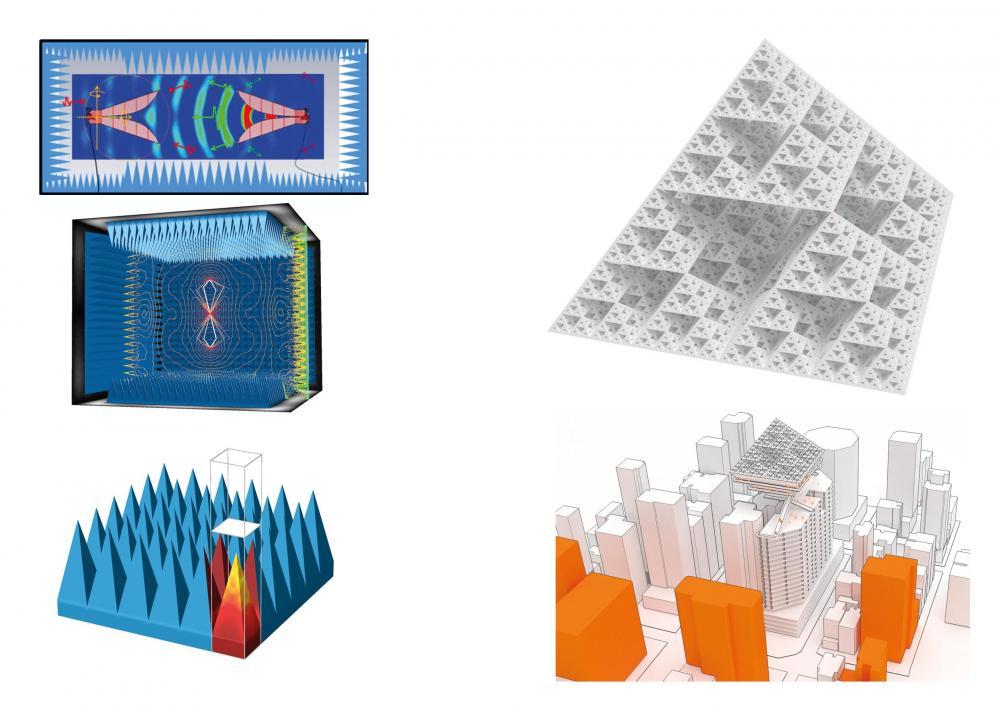Tetrahedron Architecture
Hello,
Beginner questions. I would like to model an incident electromagnetic beam reflecting/interacting with a specific geometry 'Sierpinski Tetrahedron'.
Achieving a result similar to what is shown below at primarily 2.4Ghz & 5Ghz +-
The model in question is rather large as it represents the footprint of a building
This is for architectural concept design. (postgraduate research) and i am seeking to build a case for emf attenuation within buildings to provide emf-free zones.
This link shows a project carried out within the Altair software suite and closely resembles my desired result for testing different geometries and their effect on building footprint
https://insider.altairhyperworks.com/emp-analysis-building/
(is the model for this project available for download and inspection? ( to reverse engineer the process))
And this link/video shows the animation of what I would like to achieve however with a different geometry.
Pulse wave?
I understand this is a relatively simple procedure within Feko capabilties, however time is a constraint and I would like to request the following:
1- Could someone outline the basic process to achieve this?
1.5- I am seeking to model anechoic chambers as a stand-alone feature as well. (as depicted in the attached image)
2- Is it feasible to model a large scale anechoic chamber and analyze it at the specified frequencies or will RAM requirements be too high?
3- Additionally the building geometry would act as a form of antenna and I would like to check principles of antenna optimisation could be applied on a building scale. (Efficiency of currents generated through the structure etc..
Attached are images of what I would like to achieve and the building geometry at a conceptual stage.
Thank you for your time.
Roberto
Specs:
OS: Win 8.1
Cpu: i7 4790k (4.3Ghz) (4 cores)
Ram: 16gb
Gpu: Nvidia 980m 8gb
Answers
-
Hi @Roberto7,
Incident electromagnetic beam:
Unfortunately I don't think the simulation files from the video are available for download. The principle workflow is
- Open POSTFEKO and create a time signal (Gaussian pulse). This will allow you to determine fmin and fmax for the simulation in the frequency domain.
(see this video for a quick introduction to FEKO time analysis: https://securefiletransfer.altair.de/link/yczV6Lp0HH6ObscNdRiyBF) - Create the model in CADFEKO, use a plane wave excitation. Set fmin = duration of timesignal and fmax = fmin * no. of samples
- Use continuous frequency range, ideally this will decrease the runtime for large frequency ranges.
- Note, your model will be electrically large, so expect large memory usage and long runtime with full wave solvers (e.g. MLFMM). You will probably have to switch to asymptotic solvers (PO, LE-PO, RL-GO or UTD).
- Note, this doesn't seem like a beginner's application, but still doable
/emoticons/default_wink.png' srcset='/emoticons/wink@2x.png 2x' title=';)' width='20' />
Anechoic chamber:
Simulating an anechoic chamber is a very demanding task, due to the excessive geometry and highly lossy media. Especially at higher frequencies you will quickly reach hardware limitations. You may just give it a try by modelling afew of the pyramids and investigate the computational requirements. In many cases the reflection coefficient of absorbing walls is -40 dB and less and so they can probably be neglected in the model.
Of course OPTFEKO (built-in optimiser) can be used on building scale as well.
PS: Talking of buildings, maybe WinProp is the better suited software for you? -> WinProp
0 - Open POSTFEKO and create a time signal (Gaussian pulse). This will allow you to determine fmin and fmax for the simulation in the frequency domain.


